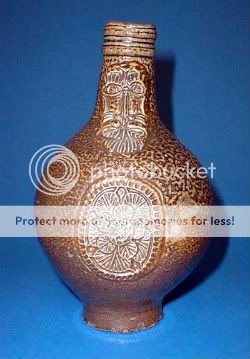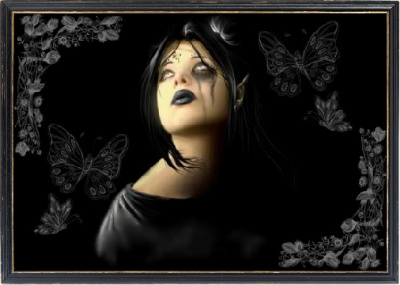05:16 Jul 08 2011
Times Read: 588
THE WITCH-BOTTLE
 Bellarmine Jar
Bellarmine Jar
The witch-bottle or sometimes referred to as a spell-bottle is not as popular these days as it was a few centuries ago. They were popular in Europe and especially in Britain. Every so often one is dug up when demolishing a building, doing a renovation or in an archaeological dig. These bottles were used for banishing and for protection.
At one point in time, it was believed that no matter how well intentioned the witch might be there would always be those who might harbor ill will toward them for some unfathomable reason. It could be jealousy or any of numerous reasons. This is where the witch-bottle came into play. It was created as a means of protection against negativity. Of course like many things that started out being used by a practitioner of witchcraft, it was turned on them in time to be the means to ward off evil spells, illness and whatever people could think up that was supposedly caused by the witch. In some cases, it might be meant to actually kill the witch.
The bottle would be hidden under the hearth stone or the doorstep because that protected the entrance into the home. Some bottles would even be put into the walls or the floors of newly built homes. Generally it was felt it would protect the household from negative magic. (1) It was believed no matter what the use, if one planned to move, the bottle should be dug up or removed from the wall or beneath the floor and be taken with the person who originally created it and put it in its hiding place. This may account for the reason so few have been discovered. Many may have later been destroyed.
The use of each bottle of course, would depend on the reason for creating such a bottle. It was dependent on whether it was merely for the sake of protection or true malice being harbored toward an individual witch and/or their family.
“A witch, cunning man or woman, would prepare the witch's bottle. Historically, the witch's bottle contained the victim's (the person who believed they had a spell put on them, for example) urine, hair or nail clippings, or red thread from sprite traps. In recent years, the witch's bottle has taken on a nicer tone, filled with rosemary, needles and pins, and red wine. Historically and currently, the bottle is then buried at the farthest corner of the property, beneath the house hearth, or placed in an inconspicuous spot in the house. It is believed that after being buried, the bottle captures evil which is impaled on the pins and needles, drowned by the wine, and sent away by the rosemary.
Sometimes seawater or earth was used instead of what was considered more common practices. Other types of Witch-bottles may contain sand, stones, knotted threads, feathers, shells, herbs, flowers, salt, vinegar, oil, coins, or ashes. A similar magical deceive is the "lemon and pins" charm. (Information on the history of lemon and pins can be found here: http://www.jesterbear.com/Aradia/lemon.html)
Another variation is within the disposal of the bottle. Some witch's bottles were thrown into a fire and when they exploded, the spell was broken or the witch supposedly killed.”(9) Another reason for the scarcity of bottles found.
There is a definite difference between how people viewed a witch considered to follow pagan beliefs and were not Christian. Those who were Christian and practiced magic, the cunning person whether it be male or female, was accepted as an asset to society. Wikipedia explains it in this way:
“The cunning folk in Britain were professional or semi-professional practitioners of magic active from the medieval period through to the early twentieth century. As cunning folk, they practiced folk magic - also known as "low magic" - although often combined this with elements of "high" or ceremonial magic, which they learned through the study of grimoires. Primarily using spells and creating charms as a part of their profession, they were most commonly employed to use their magic in order to combat malevolent witchcraft, to locate criminals, missing persons or stolen property, for fortune telling, for healing, for treasure hunting and to influence people to fall in love. Belonging "to the world of popular belief and custom,” the cunning folk's magic has been defined as being "concerned not with the mysteries of the universe and the empowerment of the magus [as ceremonial magic usually is], so much as with practical remedies for specific problems." However, other historians have noted that in some cases, there was apparently an "experimental or 'spiritual dimension’ to their magical practices, something which was possibly shamanic in nature.”(11)
The British practitioners were identified as wise men or women, pellars, wizards, dyn hysbys and in certain cases, white witches. Then there were the regional names that are attributed to men or women who practiced this type of folk magic and were considered to be basically the same.
Denmark: kloge folk
France: devins-guérisseurs and leveurs de sorts
Germany: hexenmeisters
Netherlands: toverdokters or duivelbanners
Portugal: saludadores
Spain: curanderos (11)
What is interesting is that in the 21st century at least, some of these names are being used by pagans who identify themselves as practitioners of Traditional European Witchcraft. Whereas from the stand point of historians at the time, when these terms were being used in the 1600s and later, they were all considered followers of the Christian faith rather than much older beliefs some call pagan. This was the only difference; good magic versus what some thought of as black magic or in league with Satan simply based on the difference of belief systems.
This is one theory as to why some of the names were used by the British:
“The term "cunning man" or "cunning woman" was most widely used in southern England and the Midlands, as well as in Wales. Such people were also frequently known across England as "wizards", "wise men" or "wise women", or in southern England and Wales as "conjurers" or as "dyn hysbys" in the Welsh language. In Cornwall they were sometimes referred to as "pellars,” which some etymologists suggest originated from the term "expellers,” referring to the practice of expelling evil spirits. Nineteenth-century folklorists often used the term "white witch" to refer to cunning folk, though this was infrequently used amongst the ordinary people themselves as for them, the term "witch" had general connotations of malevolence and evil.”(11)
The bottles that were used could be ceramic or glass. The glass bottles were usually blue or green and about 3 inches tall. During various time periods there were popular motifs on the bottles. In the 17th and 18th centuries, they often put faces on them. This particular version of the witch-bottle was first used in the Netherlands but spread to other areas of Europe. These bottles were often called greybeards and were usually much larger than the glass types, approximately 9 inches tall.
Germany had bottles that were referred to as Bellarmine jars, or more properly in the beginning were called bartmann jars, meaning bearded man. The Bellarmine label got attached due to a very unpopular Italian Cardinal by the name of Roberto Bellarmino, who was an Inquisitor of the Catholic Church. He persecuted many Protestants. Originally they had the face of bearded men as mentioned previously, but over time due to the infamous Cardinal his face started to be substituted for the other faces. He was thought of as an extremely evil man by those he persecuted who often referred to Bellarmino as a demon for his acts.
The Bellarmine jars were generally created to ward off the witch and not for the safety of the witch. These were created during the witch hysteria period.
“The attraction of having a face on the bottle was that it would help trick a hostile spell or wish into thinking it has found its target and then getting trapped inside as in a rat-trap. These bottles were also popularly used for burying money, with spells cast on them to deflect treasure-hunters.”(1)
Most believe that the witch-bottles originated in England but they did eventually make their way to the United States because examples of these bottles have been found. It is estimated that they have actively been used in both locales since the 1600’s.
“Some items that have been found in unearthed witch-bottles are iron nails or pins (iron was regarded as a magical metal), human hair, heart-shaped pieces of fabric, thorns, wood, small bones, and urine. People believed these bottles to be protective charms to keep witches away from the hearth or doorways, the significant entry and exit points of a house.”(3) This could very well be the origination point of the idea that vampires could not enter the home without permission.
 Found in Greenwich, England in 1990
Found in Greenwich, England in 1990
CT scans and chemical analysis, along with gas chromatography conducted by Richard Cole of the Leicester Royal Infirmary, reveal the contents of the bottle to include human urine, brimstone, 12 iron nails, eight brass pins, hair, possible navel fluff, a piece of heart-shaped leather pierced by a bent nail, and 10 fingernail clippings.
http://dsc.discovery.com/news/2009/06/04/witch-bottle.html
Here is an account that was written that explains one of the uses of the witch-bottles in the 1600s. It was believed at that time an illness was caused by witchcraft. This was their means of attempting a cure on the patient.
“A common counter spell against illness caused by witchcraft was to put the sick person's urine (and sometimes also hair and fingernail clippings) in a bottle with nails, pins, or threads, cork it tightly, and either set it to heat by the hearth or bury it in the ground. This, as Joseph Blagrave wrote in 1671, ‘will endanger the witches’ life, for … they will be grievously tormented, making their water with great difficulty, if any at all’ (The Astrological Practice of Physick (1671), 154-5; cited in Merrifield, 1987: 169). Blagrave's contemporaries Aubrey and Joseph Glanvil record instances of this causing the deaths of those responsible for a horse's bewitchment and for a woman's languishing illness (Aubrey, Miscellanies, 1696/1857: 140; Glanvil, Sadducismus Triumphatus (1681), part 2, 169-70). The theory was that the witch had created a magical link with her victim, which could be reversed via the victim's body-products; the witch would have to break the link to save herself, and the victim would recover.”(4)
This of course is an example of sympathetic magic which was very common in this time period. This type of magic is defined as: “magic based on the assumption that a person or thing can be supernaturally affected through its name or an object representing it.”(5)
Actually some sources state that in Germany in the region of Rhineland that the bottles were originally Rhenish stoneware. They were made to represent prosperity and good luck. Near the end of the 1500s much of this stoneware was imported by the English. They became mass produced for the English market and the mask that originally represented a burgher, which was a German dignitary, became more uniform in appearance for a wider market rather than catering to tradition. It was at this point they started calling them Bellarmine jars (also referred to as bottles, pots and jugs). The larger pots were used for storing acids, wine and ales while the smaller ones were used as witch-bottles. It was supposedly at this time, that people realized the jars and bottles could be used to counteract magic spells.
There are about 200 examples of these bottles and jars in museums and approximately 130 of those are of the Bellarmine type. The practice of using these bottles did continue into the 20th Century but it was in the late 1500s up to about 1700 that they were in their heyday. Both bottles shown are the same bottle. This Bellarmine bottle is the only one found fully intact and uncorked at this time.
The resurgence of pagan practices, witchcraft and now, wicca, has created a new interest in the use of witch-bottles or spell-bottles. They are used as originally intended, for protection against harm to the witch or their family and friends from negativity of some form. In all actuality, the bottles aren’t so much a protective device as much as being used for spells of all types in general. It would depend on intent really because some bottles nowadays are not always hidden away and might be seen sitting on a windowsill or on an altar. Some might still be hidden away and placed in areas far from the home buried somewhere. There are a variety of viewpoints on where they can be hidden and how they can be used. The bottles prepared in the present are slightly different depending on the spiritual outlook and use of the person creating them, yet some try to follow what they consider tradition.
If you are interested in reading an article on an American witch-bottle that was found in Pennsylvania in 1976, the article can be found here:
http://www.archaeology.org/online/features/halloween/witch_bottle.html
Bottles found in the United States are considered a rare find. This particular bottle is the only one of its type but it is still believed that the colonists knew how to make them and did employ their use. The bottle is dated in the period from 1740 to 1750.
The editor of the British Archaeology Magazine said, "Even today, instructions on how to make a witch-bottle are readily available on the internet. So is it all mumbo-jumbo, or do they really work? Dr Massey (scientist who analyzed the pictured bottle) prefers science to speculation. But he adds that another ancient bottle was discovered some years ago in a coffin. The occupant was still clutching it to his chest.”(13)
SOURCES:
1. http://www.unicorngarden.com/2grimoire04.htm
2. http://autumnearthsong.wordpress.com/2011/06/11/witches-protection-bottle/
3. http://www.networkingdomain.com/clients/agecroft/tudorlife/arts/bellarmine-witch-bottles.shtml
4. http://www.answers.com/topic/witch-bottles
5. http://www.merriam-webster.com/dictionary/sympathetic%20magic
6. http://www.potspotspots.co.uk/bellarmine-jugs-and-witch-bottles/
7. http://cka.moon-demon.co.uk/KAR007/KAR007_Bellarmine.htm
8. http://www.forteantimes.com/strangedays/archaeology/2362/witch_bottle.html
9. http://en.wikipedia.org/wiki/Witch_bottle
10. http://www.rahoorkhuit.net/library/wiccia/howto/witchbottles.html
11. http://en.wikipedia.org/wiki/Cunning_folk_in_Britain
Briggs, Robin (1996). Witches and Neighbours: The Social and Cultural Context of European Witchcraft. London: Penguin. ISBN 978-0140144383.
Davies, Owen (2003). Cunning-Folk: Popular Magic in English History. London: Hambledon Continuum. ISBN 1852852976. p. x, p. 07-13, 163, 184
De Blécourt, Willem (October 1994). "Witch Doctors, Soothsayers and Priests. On Cunning Folk in European Historiography and Tradition". Social History Vol 19, No 3.
Hutton, Ronald (1999). The Triumph of the Moon: A History of Modern Pagan Witchcraft. New York: Oxford University Press. ISBN 0198207441. pp. 84-86
Wilby, Emma (2005). Cunning Folk and Familiar Spirits: Shamanistic Visionary Traditions in Early Modern British Witchcraft and Magic. Brighton: Sussex Academic Press. ISBN 1845190785. pp. 5
12. http://www.bottesfordhistory.org.uk/page_id__69_path__0p2p46p.aspx
13. http://www.dailymail.co.uk/sciencetech/article-1190722/Archeologists-unearth-17th-century-stone-flask-buried-380-years-ago-ward-witches.html
RKB aka:
Sinistra Copyright 2011









COMMENTS
-